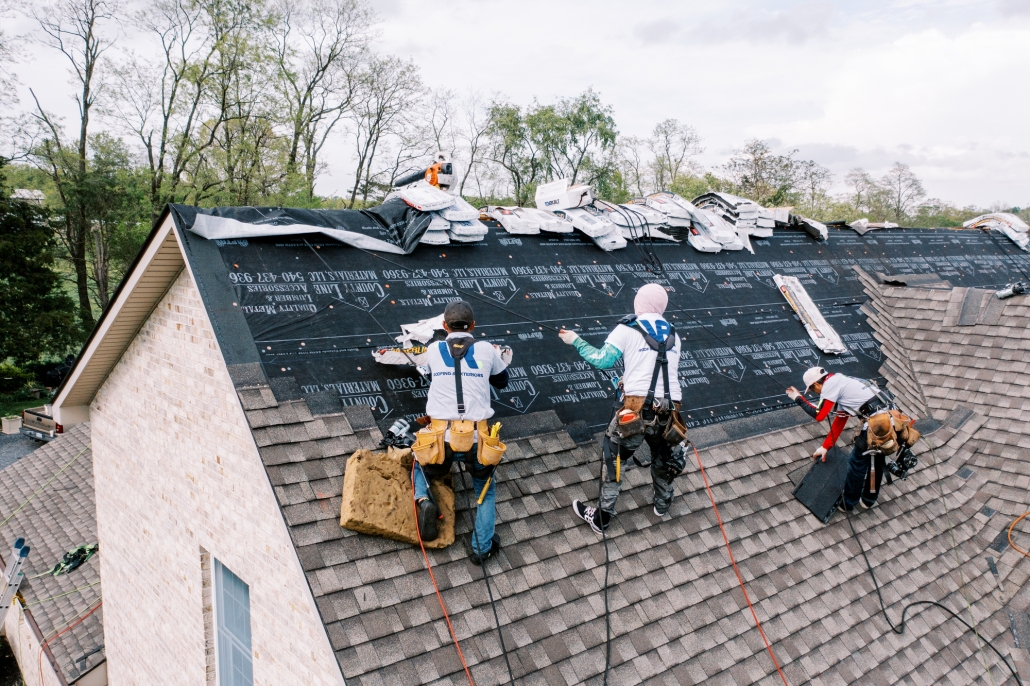Just How Gainesville Roofing Companies Can Change Your Home's Outside
Just How Gainesville Roofing Companies Can Change Your Home's Outside
Blog Article
Ideal Practices for Ensuring Appropriate Roofing Air Flow
Making sure appropriate roof ventilation is crucial for the durability and performance of a roof system. A well balanced intake and exhaust air vent ratio, frequently 1:300, plays a crucial function, with intake vents preferably positioned at the lower edge of the roofing system for awesome air entrance and exhaust vents at the height for warm air departure. Routine evaluations to determine clogs and keep clear air flow are extremely important. Maintaining insulation away from vents is crucial to stop air flow restriction. Comprehending these foundational components establishes the stage for even more thorough insights into setup and maintenance techniques that can substantially improve your roof system's efficiency.
Understand Ventilation Fundamentals
Effectively comprehending air flow essentials is vital for making certain the longevity and effectiveness of roof covering systems. Efficient ventilation alleviates dampness buildup and temperature extremes in the attic, both of which can result in significant structural damage in time. A well-ventilated roofing system assists in protecting against usual problems such as mold growth, timber rot, and ice dams, which can endanger the honesty of the roof covering materials and the underlying frameworks.
The main objective of air flow is to assist in the movement of air, enabling a regular exchange between the outdoor and interior settings. This equilibrium is attained through a combination of consumption and exhaust vents that collaborate to preserve ideal air movement. Consumption vents, usually situated along the soffits or eaves, enable fresh air to enter the attic space, while exhaust vents, typically positioned at or near the roof covering ridge, allow warm, moist air to get away.
Key aspects influencing the effectiveness of roof covering ventilation consist of correct placement, ample sizing, and making certain that both consumption and exhaust vents are unobstructed. Normal evaluation and upkeep are important to recognize possible clogs, damage, or inadequacies in the ventilation system, therefore securing the roof's performance and durability.
Kinds Of Roof Covering Vents
Roof vents play a crucial function in keeping effective attic room air flow and, by expansion, the overall wellness of the roof covering system. Numerous kinds of roof covering vents are available, each with one-of-a-kind advantages tailored to details roof requirements. Ridge vents, as an example, are set up along the roof covering's top, permitting warm, damp air to run away from the attic. They use continuous ventilation and mix flawlessly with the roofline, making them both efficient and aesthetically pleasing.

Soffit vents are set up under the eaves and job in tandem with roof vents to make certain a well balanced intake and exhaust system. By allowing cooler air to go into from below, soffit vents facilitate the expulsion of hot air through top vents. Gable vents, situated on the exterior walls of the attic room, offer another efficient solution, particularly in homes with gable roofs.
Assess Your Present Air Flow

Next, think about the age and condition of your roof covering materials and air flow elements. Older systems may not conform with current building ordinance or might have deteriorated over time, minimizing their efficiency. Conduct a detailed assessment to identify any indicators of wear and tear, such as corrosion, damage, or gaps that could jeopardize the system's efficiency.
Additionally, determine the attic room temperature level and moisture degrees. High temperatures and moisture can suggest poor air flow.
Installation Best Practices
Reliable installation of roof air flow systems is extremely important for making certain optimal performance and long life. Correct installation begins with recognizing the specific ventilation needs of the building and the roof covering it covers. This includes computing the proper proportion of consumption to exhaust vents, usually sticking to the 1:300 policy, which specifies one square foot of air flow for every single 300 square feet of attic floor space.

Consumption vents must be installed at the roofing's reduced side, typically in the soffits, to permit awesome air to go into. Exhaust vents, on the other hand, must be mounted near or at the roof covering's height to help with the leave of cozy, moist air.
Seal all air vent links diligently to stop air leaks and potential water infiltration. Use high-grade products and adhere to supplier guidelines to make certain resilience and effectiveness. Additionally, integrating ridge vents with baffles can substantially improve air movement performance by protecting against wind-driven rain and snow from getting in the attic room.
Inevitably, precise installment of roofing ventilation systems mitigates prospective issues such as mold growth, ice dams, and architectural damages, ensuring the roofing system's integrity and the structure's overall health.
Regular Upkeep Tips
Consistency in maintenance techniques is essential to ensuring the long-term efficiency of roof covering air flow systems. Normal examinations are crucial, preferably performed biannually-- in the springtime and loss. During these evaluations, make sure that vents are without debris, nests, and other blockages that might hinder airflow. Look for any indicators of wetness buildup or mold, see page as these can suggest improper air flow or leaks (roofing companies gainesville florida).
Cleaning the vents is an additional crucial task. Make use of a soft brush or a vacuum cleaner to eliminate dirt and debris from intake and exhaust vents. Beware not to harm the vent displays or louvers during the procedure. Furthermore, check the attic space for any type of signs of water damage, which might jeopardize the honesty of the roofing system.
Proper insulation is just as crucial. Ensure that attic insulation does not block the vents, as this can seriously limit airflow. Rearrange or change it to preserve an efficient obstacle. if any kind of insulation has changed or resolved.
Lastly, change any type of harmed or missing elements immediately. Busted vents, fractured shingles, or worn-out flashing can all contribute to poor air flow and ought to be attended to without hold-up. Normal More about the author upkeep ensures that the roofing air flow system functions ideally, thereby extending the life expectancy of the roofing system itself.
Final Thought
Making sure proper roof air flow is critical for keeping the performance and longevity of a roof system. Adherence to the 1:300 consumption and exhaust air vent ratio, paired with the calculated positioning of vents, is essential.
A well balanced consumption and exhaust vent proportion, typically 1:300, plays a crucial function, with intake vents preferably put at the lower side of the roofing system for great air access and exhaust vents at the top for cozy air leave. Intake vents, typically situated along the eaves or soffits, enable fresh air to enter the attic room, while exhaust vents, frequently located at or near the roof covering ridge, allow hot, humid air to get away.
Soffit vents are mounted under the eaves and work in tandem with roof vents to guarantee a well balanced consumption and exhaust system. By permitting cooler air to go into from below, soffit vents promote the expulsion of warm air through upper vents. Adherence to the 1:300 consumption and exhaust air vent proportion, paired with the calculated placement of vents, is vital.
Report this page